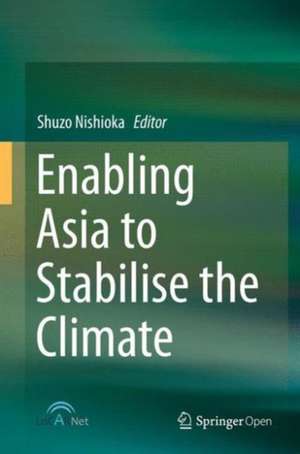Enabling Asia to Stabilise the Climate
Editat de Shuzo Nishiokaen Limba Engleză Hardback – 11 feb 2016
| Toate formatele și edițiile | Preț | Express |
|---|---|---|
| Paperback (1) | 366.78 lei 38-44 zile | |
| Springer Nature Singapore – 8 dec 2018 | 366.78 lei 38-44 zile | |
| Hardback (1) | 388.48 lei 38-44 zile | |
| Springer Nature Singapore – 11 feb 2016 | 388.48 lei 38-44 zile |
Preț: 388.48 lei
Nou
Puncte Express: 583
Preț estimativ în valută:
74.33€ • 77.82$ • 61.51£
74.33€ • 77.82$ • 61.51£
Carte tipărită la comandă
Livrare economică 01-07 aprilie
Preluare comenzi: 021 569.72.76
Specificații
ISBN-13: 9789812878250
ISBN-10: 9812878254
Pagini: 270
Ilustrații: X, 270 p. 99 illus., 70 illus. in color.
Dimensiuni: 155 x 235 x 20 mm
Greutate: 0.67 kg
Ediția:1st ed. 2016
Editura: Springer Nature Singapore
Colecția Springer
Locul publicării:Singapore, Singapore
ISBN-10: 9812878254
Pagini: 270
Ilustrații: X, 270 p. 99 illus., 70 illus. in color.
Dimensiuni: 155 x 235 x 20 mm
Greutate: 0.67 kg
Ediția:1st ed. 2016
Editura: Springer Nature Singapore
Colecția Springer
Locul publicării:Singapore, Singapore
Public țintă
ResearchCuprins
Introduction.- Part 1: Asia is a key for sustainable low carbon society.- 1. GHG reduction potential in Asia.- 2. Transition to a low carbon future in China towards 2°C Global target.- 3. India’s GHG Emission Reduction and Sustainable Development.- 4. 80% reduction scenario in Japan.- 5. Potential of low carbon development in Vietnam, from practices to legal framework.- Part 2: Brigding the gap between modeling and real policy development.- 6. Designing a National Policy Framework for NAMAs -Lesson learnt from Thailand-.- 7. ‘Science-to-Action’ of the Sustainable Low Carbon City-region.- Part 3:Best parctices and recommendations in each sector to make it happen.- 8. Low Carbon Transport in India - Assessment of Best Practice Case Studies -.- 9. Potential of Reducing GHG Emission from REDD+ Activities in Indonesia.- 10. Fostering capacity development for ASIA leapfrog.- 11. Capacity development on GHG inventories in Asia -WGIA Workshop on Greenhouse gas Inventory in Asia-.- 12. Japan’s Comprehensive and Continual Support Package for the Creation of Scientific Climate Policies in Asia.
Notă biografică
Textul de pe ultima copertă
This book presents good practices in Asia and ASEAN countries for effectively promoting advances in response to climate change, which can help to achieve sustainable development in Asia and around the world. As a proposal, the aim is to influence the discussions at COP 21 by providing a positive agenda with concrete actions from an Asian perspective. The book is divided into three parts. Part 1 describes the greenhouse gas (GHG) reduction scenario from an Asian perspective and in line with global 2 ° targets. Based on modeling analysis, the studies demonstrate the theoretical potentials and send the policymakers at COP 21 the positive message that “Asia can reach the target.” As Asian countries vary in terms of their economic strength, country-specific scenario studies for the two giants China and India as well as for Japan and Vietnam are introduced to show the different approaches for each country. Part 2 shows successful examples of how modeling analysis are reflected in actual policy development, which provides practical guidelines to help policymakers develop their own roadmaps with stakeholder dialogue, not only in Asia but also in other regions of the world. The Nationally Appropriate Mitigation Action (NAMA) roadmap development in Thailand as well as the Iskandar Malaysia project show at the country and city level how researchers and policymakers are working closely to succeed. Part 3 focuses on a number of sector-specific activities including transportation, forestry, capacity development, and inventory work in Asia. Rather than discussing the Low Carbon Society (LCS) concept in detail, the respective chapters highlight unique, concrete, and practically applicable examples from Asia, showing how Asian countries are addressing climate change mitigation issues in a collaborative manner, an approach that can be replicated in other regions. While the ultimate goal of this book is to facilitate international climate regime making, local government and international organizations (United Nations, World Bank, and others) officers, researchers, international NGO/NPOs, consultants, students (particularly those studying international relationships or environmental studies), as well as reporters will find this book useful in broadening their understanding of low-carbon development in Asia.
Caracteristici
Provides a quantitative analysis of GHG mitigation potentials in the Asian region as a whole as well as in selected key countries
Features roadmaps for achieving drastic emission reductions, and presents case studies where analysis and roadmaps are integrated within the actual policy development process
Introduces good practices in selected key sectors, providing valuable points of reference for policymakers, international organizations, researchers, and the private sector
Sends a clear and encouraging message: “Asia can achieve a low-carbon society”
Features roadmaps for achieving drastic emission reductions, and presents case studies where analysis and roadmaps are integrated within the actual policy development process
Introduces good practices in selected key sectors, providing valuable points of reference for policymakers, international organizations, researchers, and the private sector
Sends a clear and encouraging message: “Asia can achieve a low-carbon society”










